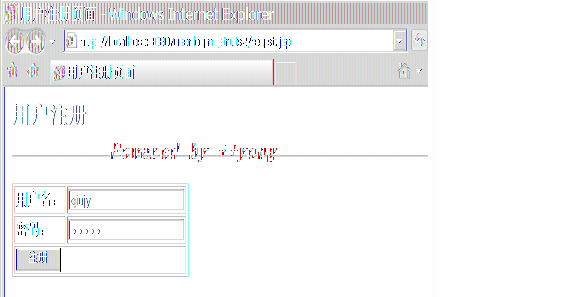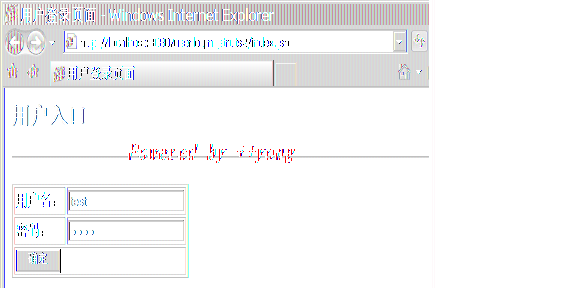一个Action内包含多个请求处理方法的处理
Struts1提供了DispatchAction,从而允许一个Action内包含多个请求处理方法。Struts2也提供了类似的功能。处理方式主要有以下三种方式:
1.1. 动态方法调用:
DMI:Dynamic Method Invocation 动态方法调用。
动态方法调用是指:表单元素的action不直接等于某个Action的名字,而是以如下形式来指定对应的动作名:
<form method="post" action="userOpt!login.action">
则用户的请求将提交到名为”userOpt”的Action实例,Action实例将调用名为”login”方法来处理请求。同时login方法的签名也是跟execute()一样,即为public String login() throws Exception。
注意:要使用动态方法调用,必须设置Struts2允许动态方法调用,通过设置struts.enable.DynamicMethodInvocation常量来完成,该常量属性的默认值是true。
1.1.1. 示例:
修改用户登录验证示例,多增加一个注册用户功能。
1. 修改Action类:
package org.qiujy.web.struts2.action;
import com.opensymphony.xwork2.ActionContext;
import com.opensymphony.xwork2.ActionSupport;
/**
*@authorqiujy
*@version1.0
*/
publicclass LoginAction extends ActionSupport{
private String userName;
private String password;
private String msg; //结果信息属性
/**
*@returnthemsg
*/
public String getMsg() {
returnmsg;
}
/**
*@parammsgthemsgtoset
*/
publicvoid setMsg(String msg) {
this.msg = msg;
}
/**
*@returntheuserName
*/
public String getUserName() {
returnuserName;
}
/**
*@paramuserNametheuserNametoset
*/
publicvoid setUserName(String userName) {
this.userName = userName;
}
/**
*@returnthepassword
*/
public String getPassword() {
returnpassword;
}
/**
*@parampasswordthepasswordtoset
*/
publicvoid setPassword(String password) {
this.password = password;
}
/**
*处理用户请求的login()方法
*@return结果导航字符串
*@throwsException
*/
public String login() throws Exception{
if("test".equals(this.userName) && "test".equals(this.password)){
msg = "登录成功,欢迎" + this.userName;
//获取ActionContext实例,通过它来访问Servlet API
ActionContext context = ActionContext.getContext();
//看session中是否已经存放了用户名,如果存放了:说明已经登录了;
//否则说明是第一次登录成功
if(null != context.getSession().get("uName")){
msg = this.userName + ":你已经登录过了!!!";
}else{
context.getSession().put("uName", this.userName);
}
returnthis.SUCCESS;
}else{
msg = "登录失败,用户名或密码错";
returnthis.ERROR;
}
}
public String regist() throws Exception{
//将用户名,密码添加到数据库中
//...
msg = "注册成功。";
returnthis.SUCCESS;
}
}
2. struts.xml文件:没有什么变化,跟以前一样配置
<!DOCTYPE struts PUBLIC
"-//Apache Software Foundation//DTD Struts Configuration 2.0//EN"
"http://struts.apache.org/dtds/struts-2.0.dtd">
<struts>
<package name="my" extends="struts-default" namespace="/manage">
<!-- 定义处理请求URL为login.action的Action -->
<action name="userOpt" class="org.qiujy.web.struts2.action.LoginAction">
<!-- 定义处理结果字符串和资源之间的映射关系 -->
<result name="success">/success.jsp</result>
<result name="error">/error.jsp</result>
</action>
</package>
</struts>
3. 页面:
index.jsp
<%@ page language="java" pageEncoding="UTF-8"%>
<html>
<head>
<title>用户登录页面</title>
</head>
<body>
<h2>用户入口</h2>
<hr>
<form action="manage/userOpt!login.action" method="post">
<table border="1">
<tr>
<td>用户名:</td>
<td><input type="text" name="userName"/></td>
</tr>
<tr>
<td>密码:</td>
<td><input type="password" name="password"/></td>
</tr>
<tr>
<td colspan="2">
<input type="submit" value=" 确定 "/>
</td>
</tr>
</table>
</form>
</body>
</html>
regist.jsp
<%@ page language="java" pageEncoding="UTF-8"%>
<html>
<head>
<title>用户注册页面</title>
</head>
<body>
<h2>用户注册</h2>
<hr>
<form action="manage/userOpt!regist.action" method="post">
<table border="1">
<tr>
<td>用户名:</td>
<td><input type="text" name="userName"/></td>
</tr>
<tr>
<td>密码:</td>
<td><input type="password" name="password"/></td>
</tr>
<tr>
<td colspan="2">
<input type="submit" value=" 注册 "/>
</td>
</tr>
</table>
</form>
</body>
</html>
1.2. 为Action配置method属性:
将Action类中的每一个处理方法都定义成一个逻辑Action方法。
<!DOCTYPE struts PUBLIC
"-//Apache Software Foundation//DTD Struts Configuration 2.0//EN"
"http://struts.apache.org/dtds/struts-2.0.dtd">
<struts>
<package name="my" extends="struts-default" namespace="/manage">
<action name="userLogin" class="org.qiujy.web.struts2.action.LoginAction" method="login">
<result name="success">/success.jsp</result>
<result name="error">/error.jsp</result>
</action>
<action name="userRegist" class="org.qiujy.web.struts2.action.LoginAction" method="regist">
<result name="success">/success.jsp</result>
<result name="error">/error.jsp</result>
</action>
</package>
</struts>
如上,把LoginAction中的login和regist方法都配置成逻辑Action。要调用login方法,则相应的把index.jsp中表单元素的action设置为"manage/userLogin.action";要调用regist方法,把regist.jsp中表单元素的action设置为"manage/userRegist.action"。
1.3. 使用通配符映射(wildcard mappings)方式:
在struts.xml文件中配置<action…>元素时,它的name、class、method属性都可支持通配符,这种通配符的方式是另一种形式的动态方法调用。
当我们使用通配符定义Action的name属性时,相当于用一个元素action定义了多个逻辑Action:
<action name="user_*"
class="org.qiujy.web.struts2.action.UserAction" method="{1}">
<result name="success">/success.jsp</result>
<result name="error">/error.jsp</result>
</action>
如上,<action name=”user_*”>定义一系列请求URL是user_*.action模式的逻辑Action。同时method属性值为一个表达式{1},表示它的值是name属性值中第一个*的值。例如:用户请求URL为user_login.action时,将调用到UserAction类的login方法;用户请求URL为user_regist.action时,将调用到UserAction类的regist方法。
|
4. 运行结果:
|



